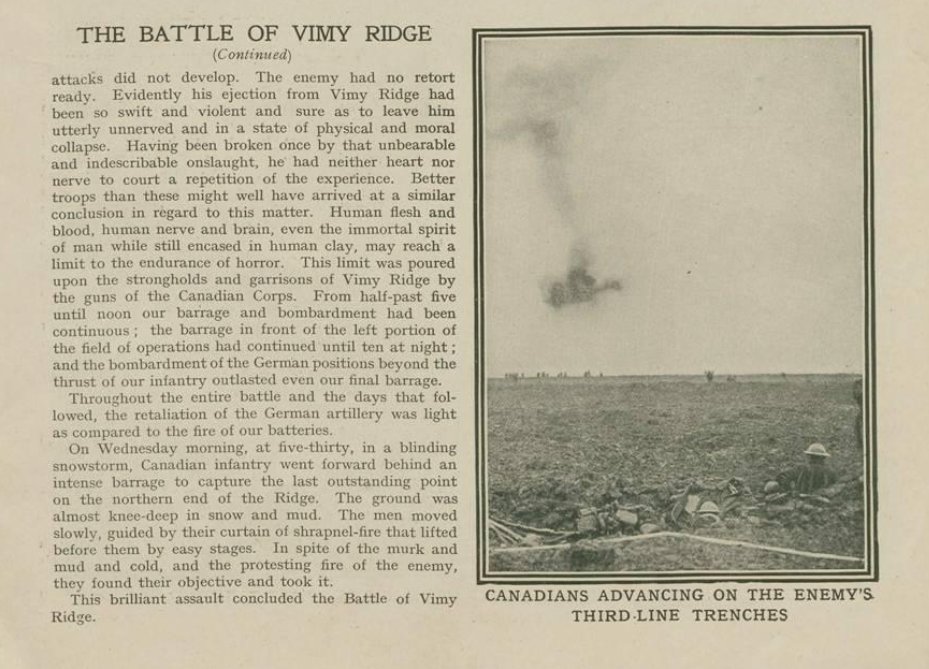
Today, let's talk about some handy tips to determine whether #FWW photographs you might have at home are Canadian or British official 👇🏼🧵 

Photograph is: Ivor Castle, A trench on the Canadian Front showing Trunk Holes, May 1917, private collection.
Photographs were available to private buyers in a number of ways - as postcards (Canadian official sold by the Daily Mirror), stereograph cards (Underwood and Underwood, Keystone), or even lantern slides (Newton).
Private buyers (ie. not newspapers or galleries) could also purchase photographic prints. For example, in the time period of 2 November 1918 - 25 January 1919, records show that the Canadian War Records Office sold more than 8,900 prints.
Who bought them? A mix of both military and civilians (the CWRO gave a discount to service members). 

Rider-Rider collected numerous orders all along the Western Front, and sent them to London to be fulfilled. It's always fun to see his handwritten order forms. 

What are some physical identifiers of official prints? They're normally all 6x8" in size.
(Private photographs that soldiers took were normally much smaller in size).
(Private photographs that soldiers took were normally much smaller in size).

Canadian official photographers normally have a negative number on them, beginning with the letter "O" followed by numbers.
This one is barely visible, is backwards, and is scratched on the lower left of this image.
This one is barely visible, is backwards, and is scratched on the lower left of this image.

Photograph is: Harry Knobel, Bacon - 1st Divisional Train, July 1916, private collection.
Slightly later prints will have it more visible from the front, like these Ivor Castle photographs from the @SeaforthOfC collection.
A Canadian covered in mud returning from the trenches, March 1917, Seaforth Highlanders Regimental Archives, 2018.413.1027.

A Canadian covered in mud returning from the trenches, March 1917, Seaforth Highlanders Regimental Archives, 2018.413.1027.


You might also see a number written in pencil on the back, or - if you're lucky - a typed caption.
Canadian official photographs have negative numbers beginning with O, while British will have multiple letters, like D, C, K, N, etc.
Newer versions of British will all have Q.



Canadian official photographs have negative numbers beginning with O, while British will have multiple letters, like D, C, K, N, etc.
Newer versions of British will all have Q.




(Notice how the above prints have press stamps? that's a pretty good sign that they were commercial in nature and were sold privately (to make their way to your collection) but long after the war ended).
Another sign: is it embossed on the front with "Copyright Canada 1919"? Many official prints were sold in Canada for years after the war, and they have this stamp (lower left corner). 

Photograph is: Ivor Castle, "Sister Susie's brothers mending shirts which Sister Susie stitched," May 1917, Seaforth Highlanders Regimental Archives, 2018.413.1463.
So, OK. You've got a photograph in your collection that looks official but you are unable to look at the back of it because it's glued into an album.
What now?!
What now?!
Well friends, I'm happy to say I've run into this several times as an under-paid and over-caffeinated art museum employee.
Does your photograph-glued-in-album have a caption? A *good* amount of the time (not always) the purchaser copied the title verbatim, or close enough.
Does your photograph-glued-in-album have a caption? A *good* amount of the time (not always) the purchaser copied the title verbatim, or close enough.
Head over the Library and Archives Canada website (Canadian photos) or National Library of Scotland (British) and search for that title in their search bar.
Why the heck am I sending you to the National Library of Scotland for British photographs? Why not the IWM?
Well kids - the IWM changed a lot of those 100+ year titles, meaning you can't search for them anymore. Nat Lib Scot didn't! Hurrah, thanks to our Scottish pals.
Well kids - the IWM changed a lot of those 100+ year titles, meaning you can't search for them anymore. Nat Lib Scot didn't! Hurrah, thanks to our Scottish pals.

Summary: Look at the size, look for a negative number, does it have press stamps?, is it embossed?, search out a caption if you have one.
Questions? Concerns? Also under-paid and over-caffeinated? I'm here for you and your super cool photographic collections 😎👇🏼
Questions? Concerns? Also under-paid and over-caffeinated? I'm here for you and your super cool photographic collections 😎👇🏼
• • •
Missing some Tweet in this thread? You can try to
force a refresh











